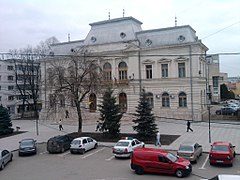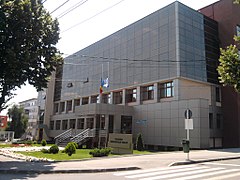Vaslui
Vaslui | |
|---|---|
County capital | |
 View of Vaslui from the northern outskirts | |
 Location of Vaslui | |
| Country | |
| County | Vaslui County |
| Status | County capital |
| Government | |
| • Mayor | Vasile Pavăl (Social Democratic Party) |
| Population (2011) | |
| • Total | 55,407 |
| Time zone | UTC+2 (EET) |
| • Summer (DST) | UTC+3 (EEST) |
| Climate | Dfb |
| Website | http://www.primariavaslui.ro/ |
Vaslui (Romanian pronunciation: [vasˈluj]), a city in eastern Romania, is the seat of Vaslui County, in the historical region of Western Moldavia.
The city administers five villages: Bahnari, Brodoc, Moara Grecilor, Rediu and Viișoara.
History
Archaeological surveys indicate that the territory of Vaslui was inhabited since the Neolithic. From the 14th century onwards, it developed as the provincial town of Vaslui, with a population that fluctuated considerably in the following centuries. The name of Vaslui appears first in a Polish document from 1375, referring to Koriat's son Yuri Koriatovich. The name Vaslui was also mentioned in 1435, in connection with the accession of Prince Iliaş to the Moldavian throne. The town was burned to the ground in 1439 and 1440 when Tatars invaded Moldavia.
The peak of Vaslui's importance was in the 15th century, when it was a second-rank capital of Moldavia, during the reign of Stephen the Great (r. 1457-1504) and its population approached that of the neighbouring Iaşi. In 1475, Prince Stephen won his greatest battle against the Ottoman Empire in the Vaslui area. Once the Moldavian capital was moved from Suceava to Iaşi and the southern town of Bârlad became an administrative center of southern Moldavia, Vaslui declined for the next three centuries to eventually become a local borough (târg).
There once was a fairly large Jewish community in the city of Vaslui. Its arrival from Galicia during the second half of the 19th century gave a new impetus to local economic development. In 1899, Jews formed 37% of the population, and Vaslui was home to the Vasloi Hasidic dynasty. However, waves of pogroms, associated with the Holocaust (see Romania during World War II and Holocaust in Romania) as well as emigration to Israel during Romania's communist period decimated this population.
During World War II, the Stephen the Great Monument was relocated from Chişinău to Vaslui. On 22 August 1944, Vaslui was captured by Soviet troops of the 2nd Ukrainian Front in the course of the Jassy–Kishinev Offensive.
The population of Vaslui grew steadily again after 1968, when the town was proclaimed as the administrative center of Vaslui County, with immigration from the neighbouring countryside, ethnic Romanians and Roma attracted by the industries set up by the Communist regime.
Demographics
According to the last census, from 2011, there were 55,407 people living within the city of Vaslui,[1] making it the 40th largest city in Romania. The ethnic makeup is as follows:
The population decreased again after the downfall of Communism in 1989, due to low fertility rate, and emigration.
Today, the majority of the population is of Romanian ethnicity. The Romani minority lives compactly in the southwestern suburbs of Rediu and Brodoc, in the southwestern part of the main town (in the neighbourhoods around Traian Street) and also scattered in the rest of the locality. In the 1960s and '70s nomadic Roma belonging to the Kalderash caste were forcibly settled by the Communists in the northern part of the town, scattered among ethnic Romanians. The third ethnic group is that of the Lipovans, who have in the center of the town a church of their Old Believers Christian branch.
Censuses
| Year | Population |
|---|---|
| 1912 | 10,397 |
| 1930 | 15,310 |
| 1941 | 13,923 |
| 1948 | 13,738 |
| 1956 | 14,850 |
| 1966 | 17,591 |
| 1977 | 39,435 |
| 1992 | 80,614 |
| 2002 | 70,267 |
| 2011 | 55,407 |
Transport
In July 1994, a trolleybus line opened. It closed in July 2009, reopening in August 2016.[2]
Sport
Vaslui is home to FC Vaslui football club which played in Liga I until 2014.
Natives
- Nicolae Milescu
- Gheorghe Mironescu
- Alexandra Nechita
- Corneliu Porumboiu
- Constantin Tănase
- Virgil Trofin
Twin towns
 Quarrata, Pistoia, Tuscany, Italy
Quarrata, Pistoia, Tuscany, Italy San Fernando de Henares, Community of Madrid, Spain
San Fernando de Henares, Community of Madrid, Spain Cahul, Republic of Moldova
Cahul, Republic of Moldova
Gallery
-
Princely Church
-
Civic Square
-
Palace of Justice
-
City Hall
References
- ^ "Population at 20 October 2011" (in Romanian). INSSE. January 2014. Retrieved 18 June 2016.
- ^ "EU funds Romanian trolley revival" Buses Magazine issue 738 September 2015 page 25






